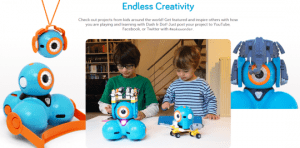How to Turn Your Kid into a Coder
The media (social and otherwise) has been buzzing lately about the importance of science, technology, engineering, and math (STEM) skills to our collective future — and, as a consequence, about the importance of teaching them to our kids.
For example, according to the Bureau of Labor Statistics, the U.S. will create 1.4 million jobs in computer science related fields by 2020. Obama’s 2009 Educate to Innovate initiative hopes to move American students from the middle to the top of the world pack in science and math over the next decade.
Even so, only about one in 10 K-12 schools teach coding. And most parents are completely unequipped to teach the topic themselves. But you don’t have to be a coder yourself to encourage your kid to be one. You just have to nurture the inner coder and know when to outsource.
That’s where coding schools come in. There are all kinds of resources, online and offline, that’ll teach kids of almost any age how to code. Even if your tot is still sucking her thumb, you can get started. Here’s how.
Step 1: Learn by playing
Just because your child can barely handle a bike with training wheels, that doesn’t mean she’s too young to learn coding. As with reading, the building blocks of logical thinking and creativity can be acquired early.
When they’re really young, kids learn best by playing. According to Ronan (above), a 10-year-old coder from Virginia, “Parents should give kids open-ended activities like an empty canvas and paintbrush or a pile of Legos just to see what they can create.”
Yolanda Wilcox Gonzalez, technology integration specialist at Beaver Country Day School, where coding is integrated into every part of the curriculum, agrees; she suggests introducing logical concepts — such as measuring — early. For example, when cooking together, let your child measure the ingredients instead of doing it yourself.
You can also give her games and apps to play with that encourage these concepts. Here are a few to consider:
ThinkFun’s Code Master is a puzzle board game that teaches logic and sequence — essential building blocks of coding. This board game won’t add to kids’ screen time, but it will help them think like a programmer. Exclusively at Target; $19.99.
Sphero SPRK edition: This robotic toy (above) is a sneaky way to get kids coding. The apps that control Sphero require it. It’s being used in schools to teach programming concepts as well as math, science, and critical thinking. $130.
Wonder Workshop: A robot-building toy (below) that teaches kids ages 5 to 12 to program, build, and create while having fun. Teachers use them because they engage kids and encourage them to collaborate. Comes in several interactive robot bundles. Starts at $150.
Puzzlets: An app-enabled toy that teaches programming by letting kids assemble toy puzzles. The puzzle pieces are essentially code for the on-screen characters. Getting the puzzle right teaches logical sequence. $100.
Step 2: Fun classes for kids
Games and toys are a great start. But the day will come when your young coder needs a teacher, software, and formal instruction. That day might happen when he’s in elementary school — or quite a bit older. “I was playing Minecraft and wanted to figure out how it worked,” explains Ronin. “Then I tried Scratch [a programming language for kids] until it got too easy for me. My parents picked up on the fact that I was ready to move to the next level, and bought me a Youth Digital class.”
Afterschool programs, camps, and online classes abound. Here are a few to have at the ready.
Youth Digital: No need to drive kids to this school. All of the instruction happens online. Kids work on projects to learn Java. The classes use video, games, rewards, and quizzes to make learning fun and engaging. And courses come with all the tools you’ll need: Blender for 3D graphics and animation, Eclipse for Java coding and development, OWL for 3D game design, and Multimedia Fusion 2 to creating video games, tools, and apps.$250 per course.
Zaniac: This after-school program and summer camp (with locations in Utah, Texas, New York, Connecticut, Florida, and Massachusetts, with more coming) is fun and colorful, and lets kids get their hands dirty playing with robotics, LEGO®, 3D Printing, Minecraft on the iPad. It also teaches kids to build, design, and sell apps in the Google Play store. A single class (to try it out) is $50.
ID Tech Camp: These summer camps are held on college campuses around the country and are taught by computer-science students at those same universities. The software used to teach is the real deal, and the computer equipment is top-notch. Kids also get a taste of college life. There are camps on a wide variety of subjects for kids ranging from 6 to 18. Expensive? Yes. But the experience could be priceless. Price for camps and courses vary, but a residential one-week programming class at UC Berkeley for teens is $3,700.
Step 3: Serious schooling
A teenager with a logical mind and some easily acquired coding skills can be out-earning her parents — in the right market — in a few months. Some kids are opting to go this route instead of (or to help pay for) college. It’s smart, and it’s a way more fulfilling and profitable first job than scooping ice cream. A coding boot camp or online school can make it happen. Here are a few to consider.
Code Academy: The mission of this online MOOC (massive open online course) is to teach the world to code. If your child has played the games, gone to camp, is motivated to learn — and has the attention span to work independently — this is a great way to get some solid coding skills in just about anything that piques her interest. Even if you aren’t sure of any of that, it’s worth a try. Free.
Make School: If everything goes well, and your spawn turns out to be a smartypants capable of conceiving of and — to some extent — creating apps, games, and other digital tools, maybe college isn’t even in the cards?Make School (”the college replacement for founders and developers”) is where young entrepreneurs can go to perfect their skills and to bring their ideas to market. It’s not easy to get in. Applicants need to be serious and ready. But tuition comes from post-graduate earnings.
Hack Reactor: Got twelve weeks? If you can get in here, it could change everything — for you and your young coder. This intensive, immersive program teaches you to think like a software engineer. You can be an adult changing careers, fresh out of college, or a smart teen who knows what he wants to do. Tuition is $17,780; some financing is available.
The Telegraph Academy: It’s a simple fact: People of color are underrepresented in tech. Thus this 12-week coding school, dedicated to bringing more diversity into the field. Your financial situation is not a factor here. There is lots of financial aid; if you can cover your own room and board for the thirteen-week program, you can afford it. This is a Hack Reactor partner school.
Article credit to: https://www.yahoo.com/tech/how-to-turn-your-kid-into-a-coder-214022173.html




